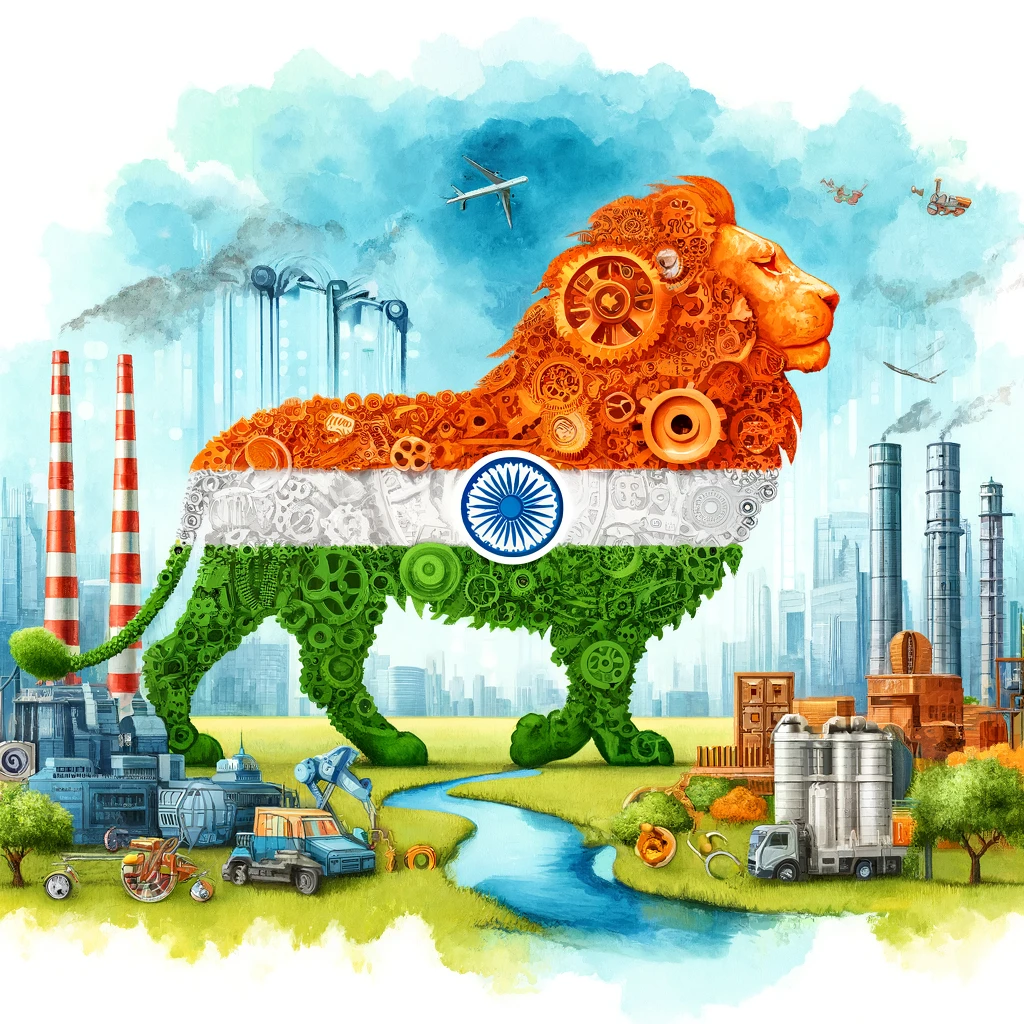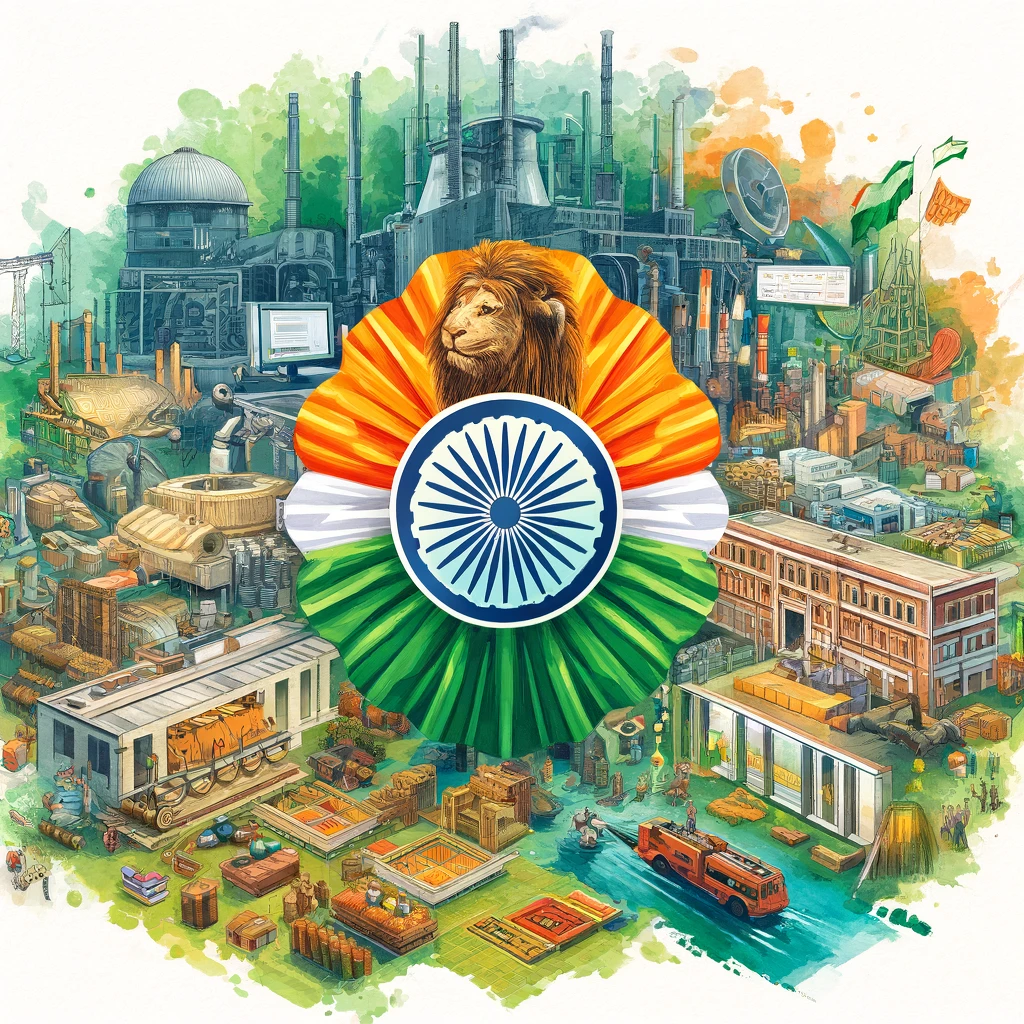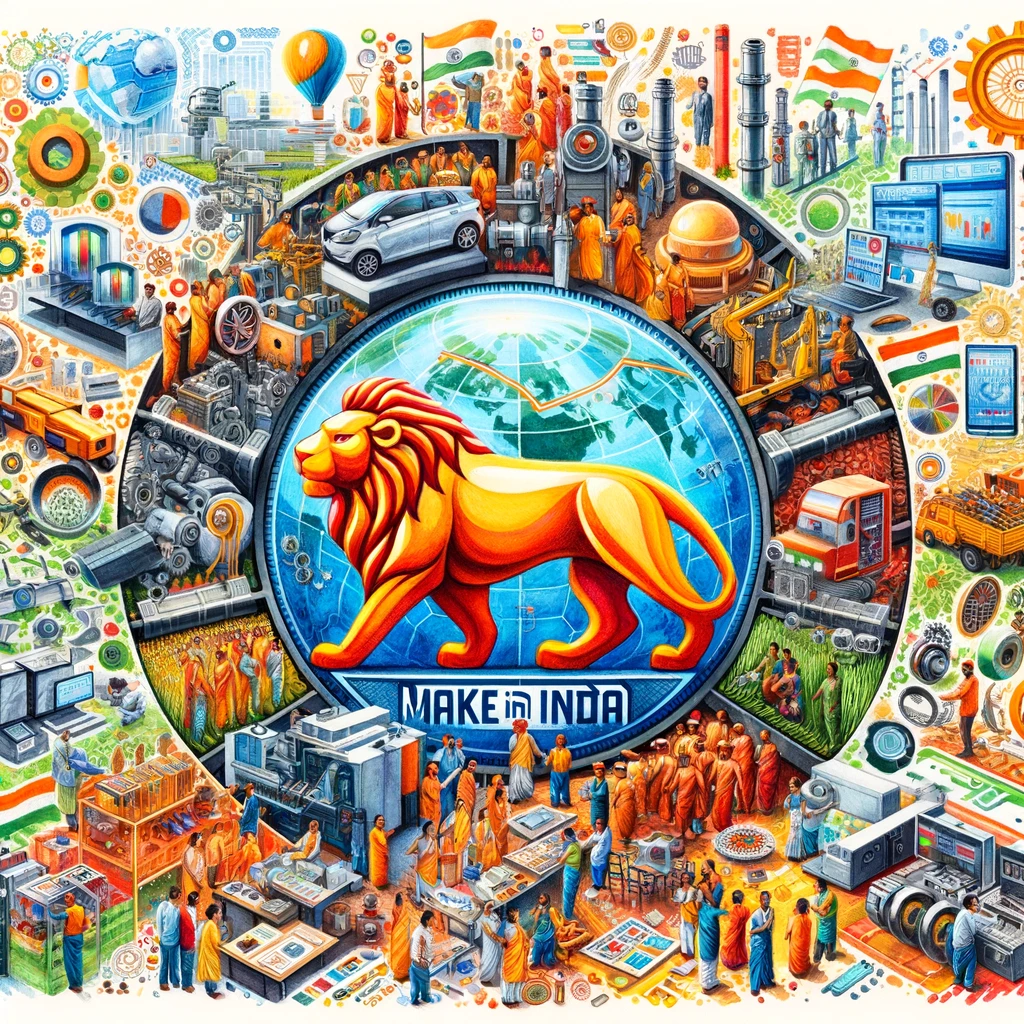Prime Minister Mr. Narendra Modi took the Make in India initiative on September 25, 2014, to chalk out an ambitious plan to make India a manufacturing hub. Make in India characterizes the reformation of India’s policies and regulations to maximize the contribution to the GDP, enhance job creation, ensure foreign investments, and simplify business operations. This means promoting greater production output in India’s manufacturing sector and putting the nation at the center of the global economy.
- “Make in India 2.0” has expanded its focus to include 27 key sectors, compared to the original 25 sectors.
- Portals like the Shram Suvidha Portal, eBiz Portal, etc. have been launched. The eBiz portal provides a single window access to 11 government services related to starting a business in India.
- Millions of jobs have been created under this initiative, addressing the employment needs of India’s young population. Emphasis on vocational training programs has also enhanced the skill sets required for modern manufacturing industries.

Key Sectors Targeted and Strategies Employed
The “Make in India” initiative was formally launched in September 2014, to ensure that India becomes a global manufacturing hub by efficient means of inviting and promoting investment, encouraging innovation, enhancing skill development, and building world-class infrastructure. This initiative encompasses an all-rounded approach to several key sectors, each with great relevance in boosting economic growth and employment within India. Below are the main targeted areas:
Key Targeted Areas/Sectors:
- Auto and Auto Components: The aim is to establish India as one of the most important automobile-producing countries in the world. The sector has attained high growth-more than 26 million vehicles were produced in 2022–23 at an unprecedented growth rate. The focus is on enhancing production, raising exports, and encouraging road electric vehicles.
- Aviation: To establish India among the big players in the global aviation market by upgrading the capability in MRO of aircraft. The rapidly growing Indian aviation industry is expected to become the third largest in 2025.
- Biotechnology: India is knocking on the doors of biosciences to develop this industry. It manufactures vaccines and biopharmaceuticals. The Indian biotechnology industry is set to touch $100 billion by 2025.
- Chemicals: This is a very important industry, which manufactures everything, from pharmaceuticals to industrial chemicals. India will work in the direction of improving its share in the world market regarding chemicals, mainly specialty chemicals and fertilizers.
- Defense Manufacturing: The Government of India has undertaken indigenous manufacturing of defense-related equipment, such as avionics and land systems, to reduce dependence on imports in this sector as well. It is estimated that the defense sector will witness investment of approximately US$10 billion by 2025.
- Electrical Machinery: On account of the surging demand for electricity, India is developing its electrical machinery manufacturing capabilities to address demand for such products as power generation and distribution equipment. The electrical machinery market will reach US$100 billion by 2025.
- Food Processing: This industry is supposed to bring value addition to agricultural products and enhance exports. More than 40 mega parks are being established by the government in food processing, to increase the current 10% to 20% by the year 2025.
- Leather and Footwear: India is one of the largest producers of leather and footwear globally. Plans for the modernization of production facilities are in place to increase exports, estimated at over $5 billion annually.
- Media and Entertainment: This will not only help create employment opportunities but also promote Indian culture across other parts of the world. It includes film production, TV, and digital media. The industry is projected to reach $100 billion by 2030.
- Pharmaceuticals: India is the global hub for generic medicines, exporting to over 200 countries. The pharmaceutical industry is expected to reach a value of $130 billion by 2030.
- Ports and Shipping: This industry works toward the betterment of the ports in India and maritime trade. Investments in port modernization and expansion are targeted to increase cargo handling capacity to over 3,000 million tonnes by 2025.
- Railways: Modernization of railways covers the development of high-speed trains and dedicated freight corridors. This sector is targeting an investment of about $120 billion in the coming five years.
- Renewable Energy: India is trying to reach the frontiers in renewable energy by setting a capacity target of 500 GW by 2030, with solar panel and wind turbine production.
- Textiles and Garments: India is among the biggest players in the textile sector. It intends to increase its exports from the current $40 billion to $100 billion by 2025. Modernization of production and a focus on high-value garments are important concerns.
- Tourism and Hospitality: The sector is assuring a display of Indian cultural heritage for international guests. In this respect, the country targets attaining a share of 2% of international tourism, while it attained a share of 1% last year.

Strategies Employed
- Reforms of regulatory policies in this regard involve simplification of regulatory procedures, the introduction of GST, and the Insolvency and Bankruptcy Code. All these have collectively contributed toward a more conducive business environment.
- Over the last ten years, FDI norms have been liberalized to allow global investors to enter most sectors.
- There are skill development initiatives such as the Pradhan Mantri Kaushal Vikas Yojana that have been launched to bridge the gap in skills and bring about a more accomplished labor force.
- Industrial corridors, smart cities, and NIP-investing in world-class manufacturing facilities.
- Promote research and development through initiatives like AIM.
Achievements and Impact on Manufacturing Growth
Since its inception, the Make in India initiative has recorded several achievements:
- Increased FDI Inflows: India witnessed a substantial rise in FDI inflows, with the country attracting over $60 billion in 2019–20, a significant increase from previous years.
- Manufacturing Growth: The Gross Value Added (GVA) in manufacturing increased from 16% of GDP in 2014–15 to around 18% in recent years.
- Employment Generation: The initiative has created millions of jobs, particularly in sectors like automobiles, electronics, and textiles. For example, the electronics manufacturing sector alone has generated over 2 million jobs.
- Boost in Exports: Manufacturing exports have seen an upward trend, with sectors like pharmaceuticals and automobiles leading the way. India’s pharmaceutical exports reached $24.4 billion in 2020–21.
- Improved Ease of Doing Business: India improved its ranking in the World Bank’s Ease of Doing Business Index, moving from 142nd in 2014 to 63rd in 2020.
Challenges and Criticisms
Despite its successes, the Make in India initiative faces several challenges:
- Infrastructure Deficiencies: Inadequate infrastructure, particularly on the logistics and power supply front, has retarded the growth of manufacturing.
- Unduly complex regulations and bureaucratic red tape have continued to discourage investment in Regulatory Hurdles.
- Skill mismatch: There is a yawning gap between available skills in the workforce and the requirements of industries in the Skill mismatch area.
- Slow Implementation: Inordinate delays in implementing some key policies and projects have resulted in slow progress being made.
- Imports Dependence: High dependence on imports of raw materials/intermediate goods, especially for high-tech industries.

Criticisms
- Overemphasis on Foreign Investment: Critics argue that the initiative focuses too much on attracting foreign investment, often at the expense of supporting domestic small and medium enterprises (SMEs).
- Environmental Concerns: Rapid industrialization has raised concerns about environmental sustainability and the need for stringent regulations to mitigate pollution and ecological degradation.
Future Roadmap and Recommendations for Enhancing Effectiveness
To further enhance the effectiveness of the Make in India initiative, the following steps are recommended:
- Infrastructure Building: Encourage investment in the modernization and expansion of infrastructure, like transportation, logistics, and energy sectors, to help manufacturers reach their products to consumers in a timely and cost-effective manner.
- Simplification of Regulations: Streamlining regulatory procedures and increasing transparency should be continued to create an enabling business environment.
- Skill Development: Increased efforts are required to bridge the gap in skilled labor through vocational training programs and by bringing industry and academia on a single platform.
- Promotion of Innovation: Enhanced funding for R&D and support to start-ups to promote innovation in manufacturing.
- Environmental Sustainability: The a need to formulate and implement strict environmental laws and regulations, as well as promote green technologies that will ensure sustainable industrial growth.
- Support SMEs: Support needs to be given more to small and medium enterprises in access to finance, technology, and market linkages.
Conclusion
The Make in India initiative is a strong base to transform India into a global manufacturing hub through the Make in India initiative. A lot has been achieved, yet there is further scope to effectively address the challenges and utilize the emerging opportunities for sustained industrial growth. With strategic policy intervention, India could harness the potential and contribute to economic development, thereby creating a prosperous and inclusive future for its people.
| Make in India UPSC Notes |
| 1. Make in India was launched by Prime Minister Narendra Modi on September 25, 2014, to make India a global manufacturing hub through policy reforms and attracting investments. 2. From an initial focus on 25 sectors, the coverage has expanded to 27 key sectors, adding new areas such as renewable energy and biotechnology. 3. Various portals, such as Shram Suvidha and eBiz, facilitate doing business by availing multiple government services through a single window. 4. Millions of jobs have been created, and vocational training programs have upgraded the skills of the manpower for the modern manufacturing industry. 5. Targeted sectors include auto, aviation, biotechnology, defense, and renewable energy for growth, exports, and employment generation. 6. The share of the manufacturing sector in GDP has gone up from 16% in 2014 to around 18%, with increased foreign direct investment and improved export performance. 7. In the World Bank’s Ease of Doing Business Ranking, India leaped from 142nd rank in 2014 to 63rd rank in 2020. 8. Some of the other challenges that this initiative is going to face are inadequate infrastructure, issues related to regulations, skill mismatch, dependence on raw material imports, and so on. |


